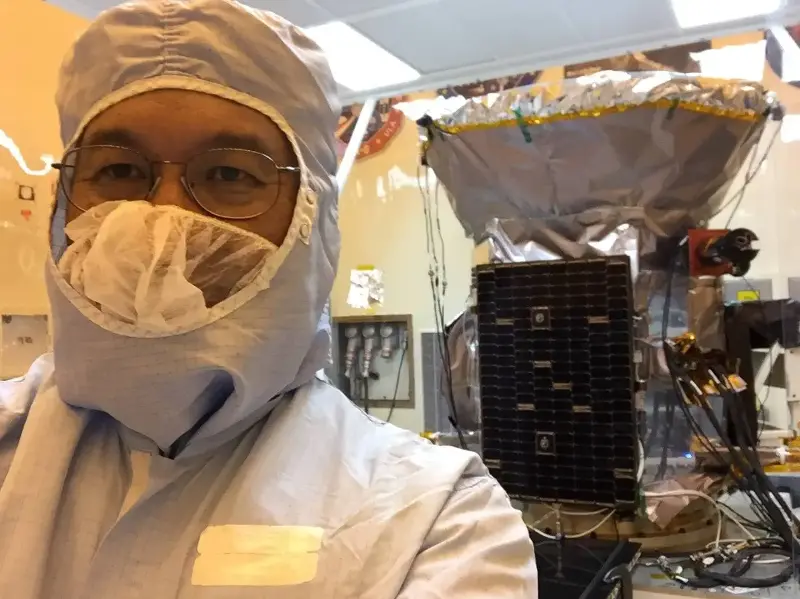
Joel Villasenor has dreamed of going to space since he was a boy. Now, at 63, he dreams of seeing the first Filipino go to space “the right way.”
He is a believer of doing things the right way. At his aunt’s place on a Monday in 1969, the young Villasenor watched on television the first men to walk on the moon.
“I was a child of the moonshot,” he said proudly. He knew right away that he wanted to be an astronaut and that he had to study at institutions that would make this dream a reality — the proper way of doing things.
He attended grade school at Ateneo de Manila University, a stone’s throw away from where he lives along Katipunan Avenue. His eyesight wasn’t great, and he said he knew from the beginning this would be a hindrance to his dream of being an astronaut — that, and the fact that the first astronauts were all military men.
“I’m going to be a mission specialist,” Villasenor said of the time he made his decision. “I’m going to be one of those doctors.”
After Ateneo, he went on to study at the Philippine Science High School. After that, a leap of faith: he crossed the Pacific to study physics at the California Institute of Technology in Pasadena, Los Angeles.
The year was 1980, and a storm was brewing in the Philippines. At the time, it was uncommon for Filipino kids to go straight abroad for undergraduate studies. Only a few had the opportunity. Young people like Villasenor had to make do with sparse contact with family through long-distance phone calls and the mail.
Today, Villasenor works as a research scientist at the Massachusetts Institute of Technology in Cambridge, where he took his post-graduate studies.
Doing things the proper way, as he planned out early on, bore the work he’d dreamed of.
Over the past decades, Villasenor has worked with teams that scoured the universe for gamma-ray bursts and, in another project, fast-spinning neuron stars. He’s among the scientists who created and launched the High Energy Transient Explorer (HETE-2) that looked for gamma-ray bursts, explosive events in the universe associated with the birth of black holes.
“We took in all the lessons from the last attempt, placed it in a different orbit, and even put in a new type of X-ray camera I and the team developed,” said Villasenor. “We launched HETE-2 on October 9, 2000.”

Now, he’s among scientists looking for planets beyond our solar system through the Transiting Exoplanet Survey Satellite.
In all those years, Villasenor settled in the United States and got married in 1999 to economist Agnes Quisimbing, whom he met during an Easter gathering at Yale University.
He recently visited the Philippines from April to June under a Fulbright grant to provide consultations for the Philippine Space Agency’s (PhilSA) satellite projects.
Villasenor met with Rappler days before he left again for the US. At a coffee shop in Pasig City, the astrophysicist ordered a cup of cappuccino. He asked me if he chose the right table. Is it too warm, too cold? He has a round face and a mop of gray hair.
As part of his visit, he went on a lecture circuit in schools, from Manila to Davao, where he had the chance to promote the newly formed PhilSA. A lecture he gave at the PhilSA headquarters was about the “imminent revolution and expansion of space activity.”
This subject moved Villasenor to wax philosophical — beyond his usual shoptalk and his personal excitement of finally getting into space (“I’m excited because I’m finally getting that ride into space before I die!”).
What does he think of the “tech bros” who want to dominate the space race? He mentioned the German chemist Fritz Haber, a Nobel prize winner whose invention was crucial in the production of synthetic fertilizers and in chemical warfare during World War I. His work was used in the gas chambers that killed millions of Jews during the Holocaust.
“He is a man who, you know, you can say fed billions but killed millions,” said Villasenor. His point in using Haber as an example was to draw the uncomfortable ordeal of separating the person from their work and legacy.

Space is becoming more accessible amid the breakthroughs of the past decades. Think Elon Musk and his reusable Falcons or Katy Perry and her 11-minute spaceflight aboard Jeff Bezos’ Blue Origin.
“Right now, somebody can just plunk in 300,000 bucks and become the first Filipino in space in a suborbital flight,” said Villasenor.
“But I keep posing that question: Is this how we want to go as a nation? Is this how we want to proceed forward?”
For him, it’s not a question of whether the Philippines is going to be a space-faring nation or not. It’s just a matter of time. And despite the commercialization of space, the myth of the space-faring human continues to fascinate Villasenor.
Whoever becomes the first Filipino to go to space, he said, would “forever become a hero.”
“Let’s do it the right way,” he said. “Let’s try to encourage and go forward as a nation trying to establish the right links.” – Rappler.com
